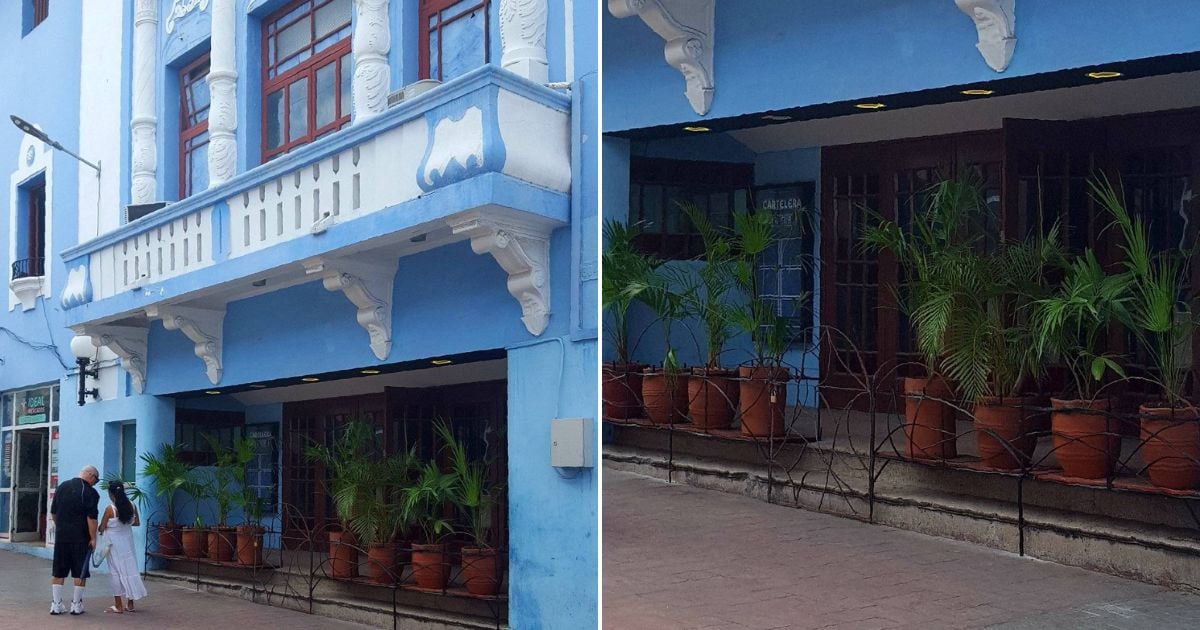
The placement of ornamental plants and fences on the façade of the Cuba cinema in Santiago de Cuba, aimed at preventing homeless individuals from using the corridor as a sleeping area, has sparked controversy on social media.
Eduardo Meneau shared a photo in the Facebook group “Old Photos, Province, Santiago de Cuba” that shows the entrance of the iconic cinema in the city, sparking divided opinions about the controversial decision.
Some criticize the decision to install railings and add ornamental plants, elements that not only clash with the building's façade but also create architectural barriers.
However, most opinions agree that the initiative aims to "hide" the homeless people who often sit on the steps leading to the building and use that space to sleep at night.
Hector Labadí Hierrezuelo stated, "I believe it was intended to keep people who are wandering around from being there, something that could have been avoided, and nowadays we see Enramadas completely overcrowded with them, including children begging for money."
For her part, Josefa Montalvan Santana criticized the measure, stating that the decision, which restricts both the entry and exit of people, could lead to a disaster: "No one thought that if an event is held and there is an earthquake or a fire, those inside would be trapped. I don’t understand how the firefighters and civil defense allow this."
The internet user Ramon Avivar pointed to a possible act of corruption: “How much did the micro, small, and medium enterprise or the TCP that did the work charge? Following the money trail has always yielded results.”
Others, like Coolhand ELpeje, believe that the solution lies in addressing the issue of homelessness rather than sweeping it under the rug: “The city needs to do a better job with social work; there should also be a possibility of thinking a bit more and seeking a better solution to these problems that didn’t just fall from the sky; there is a cause behind them...”
“They did that to keep people from wandering and sleeping at the entrance. They don’t care about the aesthetics or the architecture of the city. The tree-lined street lost the beauty that once defined it a long time ago; now it’s a dark corridor, with dimmed shop windows that are poorly decorated,” expressed María Caridad Llopiz Carbonell.
The measure, however, has also found supporters.
María Antonia Medina Téllez noted that she found it "appropriate," as she believes it was necessary to "prevent people in depressed conditions from lying around. The last time, the plague wouldn’t let me walk past the walls covered in excrement and urine."
This sentiment is echoed by Carlos Terrero, who noted: “It had already turned into a public restroom, a bed for drunks and homeless people. I think it was for the best; sometimes to have an opinion about something, you need to be there. Without intending to offend anyone, it was the best decision for such an emblematic place in my Santiago.”
However, recently the Cuban Prime Minister, Manuel Marrero Cruz, criticized the management of some regime leaders, accusing them of being "clumsy" and of having an insensitive attitude towards the issues that concern the population.
Meeting in Gibara with residents he claims to represent from his seat in the National Assembly of People's Power, the prime minister "learned about their concerns and anxieties," according to a report from the official television news (NTV).
However, instances of "slapdash work" are common in Cuba.
Recently, a new incident occurred on the streets of Havana, sparking mockery on social media, after a Cuban identified as Yulier Rodríguez shared a video showing a defective painting on the curbs of Calzada de Luyanó.
"I was walking down Calzada de Luyanó, and they're painting the curbs because, you know, every time one of these frauds is about to pass, they paint the curbs. And suddenly, I find myself asking, 'Tato, what is this?'" the user commented with laughter in their Facebook post.
Filed under: